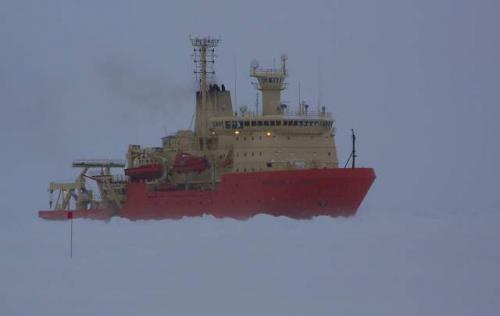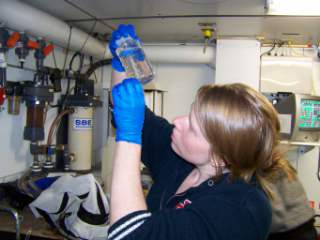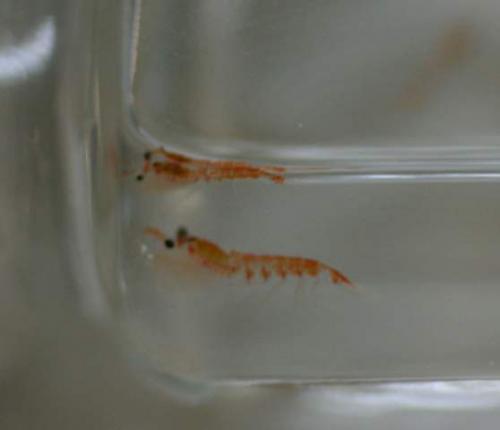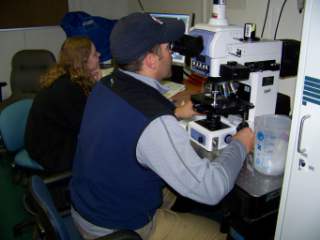Location: Ice Station Belgica
Latitude: 70° 09 S Longitude: 94° 21 W Air temperature: -7.3 °C (18.9 °F) Wind chill: -8.7 (16.3 °F) Wind speed: 5 to 10 knots Barometric pressure: 987.8 mBar
Antarctic trivia (answer at the end of this journal entry): If you walked in a circle around the South Pole you would cross through every time zone on Earth. So, since every time zone is possible in Antarctica, how do you tell time here?
**Palmer In Ice
 **
**
How did my port view suddenly become starboard? What happened to the open water that was outside my window last night? Where did our work site go? These questions were asked by a number of disoriented people when awakening this morning. The ship was turned around in the early morning hours to expose the starboard side of the ship to the open water to run a CTD cast first thing. When running at slow speeds in calm waters you don’t notice that the ship is moving, so our temporary repositioning was a surprise to many when looking out their window this morning. The CTD cast was the first activity in another busy day on the ship and on the ice.
I have acquired enough training now to master the art of sample bottle filling from the CTD rosette, so I helped with that task today. It probably seems to you that bottle filling wouldn’t require any special skills, but I assure you, these scientists take everything very seriously, and training was definitely in order. First I learned that there is a definite pecking order for bottle filling – for various reasons certain people need to collect water from the rosette before others. The scientist for whom I was filling bottles happens to have the lowest position on the CTD totem pole, so I had to wait for everyone else to fill their bottles, vials, and other really cool glassware with water from depths as great as 2700 meters before I got to play. The second thing I learned is that when it’s your turn at the rosette you put on sterile gloves, open the rosette valve and rinse your sample bottle three times to make sure that the bottle is clean. No problem, I understand the whole cleanliness bit. Here’s the downside…it turns out that the water comes out of the bottle under a bit of pressure, so it becomes a projectile that seems to land exactly where your right foot is placed.
Bruno must have noticed my less than dry feet after my first bottle filling experience because he took me aside and told me about the ritual of what he called the CTD "dance.” He explained that this carefully choreographed routine warrants a certain dress code – waterproof footwear (usually boots) is worn by all experienced CTDers. Looking around the room I confirmed this, and also I noticed that it’s important to tuck your jeans into the top of your boots – so that’s how you dress for a CTD. I guess that my first bottle filling was kind of an initiation into the CTD club; almost like my initiation into the XBT launching club…I’m still recovering from that ballistic, shoulder-numbing XBT launch. If only someone would have warned me about that XBT. I guess the XBTers aren’t as nice as the CTDers. Thanks, Bruno! Today’s bottles were successfully filled by the very-well-trained me and delivered to the lab for processing.
The weather was wonderful this morning; bright sunshine made the cool temperatures (-14 °C or so) feel a lot better. Chris, our resident ice biologist, mounted a fish finder on the ship earlier in the cruise. He detected a swarm of krill (small shrimp-like crustaceans that are food for many organisms in this ecosystem) at a depth 25 meters early this morning. Several Minke whales were seen off the back of the ship most of the morning; they were no doubt enjoying a feast of krill.
 Beverly examines a krill sample.
Beverly examines a krill sample.
 Krill are food for many organisms in Antarctica.
Krill are food for many organisms in Antarctica.
Chris has pulled up krill from the water while drilling holes in the ice. He says that the abundant krill and our numerous seal, penguin, and whale sitings are indications that this is a very biologically productive area. He’ll be studying the microorganisms found in the water, slush and ice he samples during the cruise.
 Chris and Isabelle examine the microscopic life found in sea ice.
Chris and Isabelle examine the microscopic life found in sea ice.
More than a dozen crabeater seals hauled out early today and spent the day snoozing on the ice off the bow of the ship. Brent thinks that about 2/3 of the females he has seen are pregnant and that we might be here long enough to see their pups. I was on the bridge this evening when most of them went back in the water to feed. Several of them rolled on their back and nuzzled their head in the snow; they looked like puppies rolling in grass. Brent calls the crabeaters the "golden retrievers” of the seal world because of these behaviors. Our emperor friends have been around also. I haven’t gotten tired of their antics. Today I watched 2 emperors slide on their bellies to the side of an ice floe as if they were headed for the water. They were able to move well on their bellies because the surface was slick in most places. To get to their feet they extended their flippers to the side, then placed their beak on the ice and pushed themselves up to a standing position. I hope I can capture this on video; it’s too funny to miss!
Our nice weather in the morning turned to cloudy, windy and surprisingly warmer by the afternoon. But just because the thermometer says its warmer doesn’t mean it feels warmer. Spend a little time here and you’ll understand why Antarctica is famous for its winds. But, as long as you are properly dressed, spending time outside under these conditions is surprisingly comfortable! Considering that I’ve lived in south central Texas most of the past thirty years, that’s saying a lot. I might even be persuaded to move to a colder climate…how are the winters in Dallas?
Answer to today’s Antarctic trivia question: If you walked in a circle around the South Pole you would cross through every time zone on Earth. So, since there every time zone is possible in Antarctica, how do you tell time here?
Since so many time zones are possible in Antarctica everyone here is in the same time zone. Formerly known as Zulu time, Greenwich Mean Time (GMT) is used throughout Antarctica so that everyone is on the same schedule. GMT is the time zone that runs through Greenwich, England.
(On the Palmer we keep time in a variety of ways. Official time is GMT, but for our normal activities we use the time zone of our departure port, Punta Arenas (Eastern Time). GMT is four hours ahead of Eastern Time. To make things more complicated, we use military time, which uses a twenty-four hour clock instead of the twelve hour clock that we are accustomed to. So, if GMT is 19:00 you subtract four hours to get local time, which is 15:00. Subtract 12:00 from 15:00 to get 3:00. It’s a lot of work to figure out what time it is around here!)
**Try this: ** Find a time zone map and figure out how your time zone differs from GMT. Spend a day in "GMT time” – when is "midnight?”
Figure out why Greenwich England is used as a basis for time zones.
Marine mammals and sea birds spotted today by Brent: Emperor penguin Snow petrel Giant petrel Crabeater seal Minke whale

